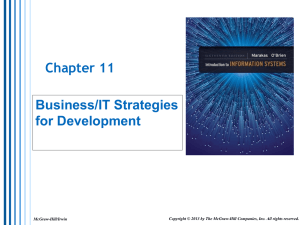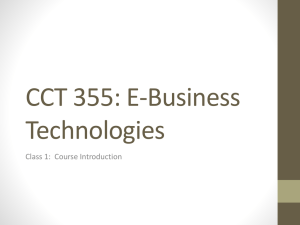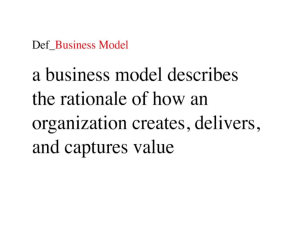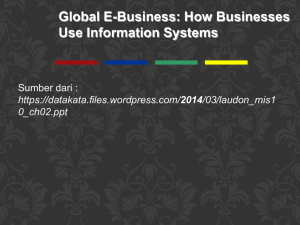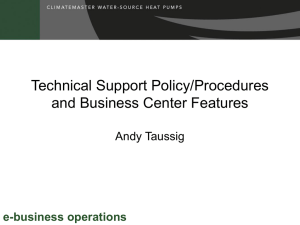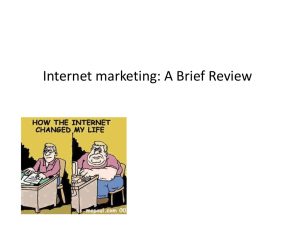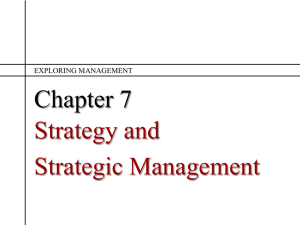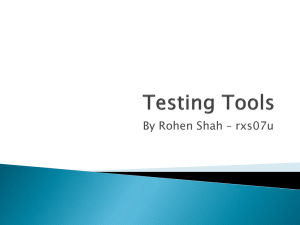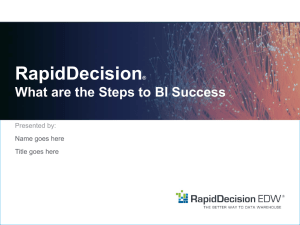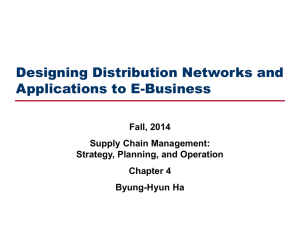lecture1 - ITU old blogs
advertisement
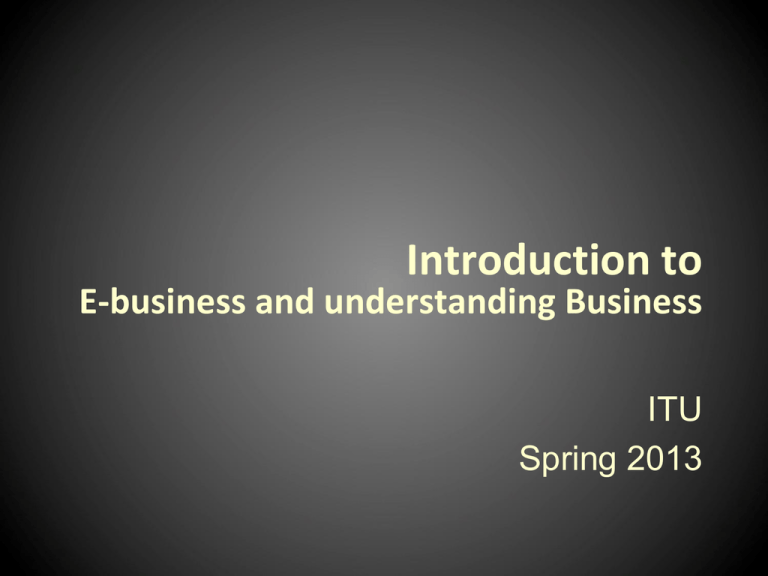
Introduction to E-business and understanding Business ITU Spring 2013 Goals of the course • The course provides insight into e-business projects by giving students a high-level understanding for the interplay between organization, e-business concepts, strategies and it solutions. • After the course, the student will be able to play an active part in development and implementation of e-business initiatives. 2 Learning Outcomes • A student who has met the objectives of the course will be able to: • Define key e-business concepts, strategies, tools, frameworks, theories, methods and technologies • Identify trends and developments within e-business for different types of enterprises and industries • Characterize relevant e-business concepts in respect to type of company and industry • Analyze a specific company´s organization, culture, strategy, environment and key processes • Argue for appropriate choice of e-business concepts for a specific company • Discuss relevant key issues in managing e-business for a specific company • Integrate analysis, chosen e-business concepts and theories and discussion on managing e-business - into a coherent academic written business report 3 Content • The class combines theory and practical experience of conducting e-business projects. • We examine different business models and discuss their potentials and challenges. During the course we work with YOUR cases, that provides better understanding of possibilities and challenges. • Subjects: organization, teamwork, business models, strategies, new technologies within e-business, and a presentation of new ways to conduct e-business. 4 Who am i? • Ulrik Falktoft • Msc.it in e-business from ITU • Worked since 1998 as independent consultant with business development, strategy, innovation, e-business and more • External lecturer at CBS and IT-University in perspectives on ebusiness (EBUSS), knowledge management and learning organizations (Master) and e-business and understanding business (DMD) • External lecturer at DTU and AAUK in computer-supported communication and distributed co-operation, introduction to ebusiness and supervising bachelor og and master thesises 5 Who are Troels? • • • • • Bachelor? Courses at EBUSS? Interests? Thesis? Other? 6 Who are you? • • • • Different programs and/or courses? Different profiles? Different nationalities? Other…? 7 Materials and teaching • Textbook – Dave Chaffey: "E-business and E-commerce Management," 5th edition, Prentice Hall, 2011 • Old Chinese proverb: - Tell me – and I will forget - Show me – and I might remember - Involve me – and I will understand • So interactive lectures means: • • • • I don’t want to talk all day I expect you to discuss and come with input and questions You will groupwise work and present as we go along Not mandatory assignments – possibility for getting feedback 8 Groups • We will today make groups • You will be responsible for presenting as we go along • Groups does not mean that you should slack! • Groups mean participation and collective responsibility • .. If one member fails to deliver - the group is responsible for providing • So: act responsible… 9 Exam • 2013-05-15: Submit written report (30-50 pages per group) • 2012-06-12/13/14/17/18: Oral exam (probably one or two days) 10 Any questions so far? 11 I have some questions! • What is e-business? – Can you come up with examples? – What is e-commerce? 12 E-business is.. • Marketing, buying, selling, delivering, servicing, and paying for products , services and information across networks linking an enterprise and its prospects, customers, agents, suppliers, competitors, allies and complementors. • OR: All aspects of business (using IT) • IT-infrastructure, Internet, 3G /Edge and other distributed digital technologies And e-commerce…? … plus e-management E-commerce E-business E-Management So what is new? • Some say that a e-business revolution is taking place today • Migration from place to space • Which e-business models will succeed with current channels to customers? • What are the key challenges facing established businesses migrating from traditional market place to a combination of place and space? 16 Collapse of the distribution chain Grower Transporter $8.00 Wholesaler $12.00 Florist $24.00 Consumer $60.00 Consumer $54.00 Disintermediation of consumer distribution channel Channel conflicts • Channel conflicts have always existed but they are amplified by the Internet • The myth • Elimination of all intermediaries • Easy identification of buyers and sellers - no need for middlemen • The reality • The Internet challenges intermediaries • New types of intermediaries have appeared Dis-, re- and countermediation Types of intermediaries • • • • • Directories (Yahoo) Search engines (Google) Virtual resellers (Amazon) Financial intermediaries (Nordnet) Evaluators (comparison site) Added value of intermediary • • • • • • • Payment - credit card, letter of credit Information - news, reports, use flashes; product information Trust - relationship, certificates, membership Pricing - auction, fixed pricing, volume discount Shipping - services, insurance, custom handling Mall - list of vendors Community - chat, discussion groups, conferences The main functions of markets • matching buyers and sellers • facilitating the exchange of information, goods, services, and payments • providing a • Legal • regulatory framework Marketplace vs. Marketspace Marketplace • Cash • Checks • Paper documents • Store fronts • Face-to-face meetings Marketspace • Information becomes digital • Costs of replication and distribution lowered • Small vs. big company Motivations for e-business • Huge growth in e-business • Most people in developed countries have internet access • Estimated size of e-business in the US: • 2001-2002: 330 billion US$ revenue • 2003-2005: 1 trillion US$ revenue • Though disintermediation has received a lot of attention , intermediaries account for 20% of the revenue within ebusiness • Growth in dot-coms • Operate predominantly in space • Often pioneering and testing new business models What kind of market models? • There are four basic market models for e-commerce: • • • • Store front model Auction model Portal model Dynamic pricing model Store front sites • Combines seller and buyer directly • A single or company web site where products and services are sold • Mechanisms necessary for conducting the sale: – Browsing online product catalogue – Adding products to shopping chart – Checking out products – Paying online – Physical products are usually shipped directly to customers’ home address • An online shopping center where many stores are located – some are merely directories – some provide shared services – some are actually large click-and-mortar retailers (a store that exists online and in the physical world) – some are virtual retailers Auction sites • A place for buyers and sellers to negotiate a price for a product • Auctions can be done: – online or off-line – at public sites (eBay) or at private sites (by invitation) • Different models – Traditional auctioning (buyers bid) – Reverse auctioning (sellers bid) – Dutch auctioning (price falls constantly) • Commission paid to the site Portals • A place where you can find everything • Horizontal portals – Broad range of information, Yahoo • Vertical portals – Single area of interest, WebMd.com • Commission from advertisers or percentage of sale Dynamic price sites • Name-your-price model – E.g. Peters pris • Comparison pricing model – E.g. hi-fi priser, Kelkoo • Bartering model – E.g. Swap.com • Offering free products and services model – E.g. telephone operators Some conclusions • Several examples of e-business pioneers will drive traditional businesses to conduct e-business as well • These traditional businesses will evolve from current business models to a combination of place and space • E-business often amplify channel conflicts • E-business enables a total reengineering of all internal and inter-organizational business processes, and will fundamentally challenge industry structures DOT-com (or DOT-death) • To optimistic prospects around 1999-2001 • A lot ordinary businesses that just went electronic did not make it • Other transformed into new ways of doing their business • And change and transformation - that is the real challenge when going from ”old” business to e-business • An example of a good transformation… The second wave of e-business • Three important characteristics: • Lower, more realistic, stock market valuations • Existing firms will transform to an e-business model (place and space) • Cheaper , higher quality services • Distinctions between B2B, B2C and C2C will disappear The third wave • Cloud, SaaS and last but not least – smartphones (in all shappes and forms) • What is different from cloud and smartphone apps – something we didn’t see 10 years ago? We must still understand business • Way to many business fail when trying to transform into ebusiness • That is often because they don’t understand the basics of their own organization, strategy, culture and leadership • It furthermore takes a new understanding of customers • An how to transform and change – while the environment change.. Customers Waves of change Form groups • Form af group of 6 persons with 4 other Belbin types • Do a short presentation of each individual • Tell the others is you know that there are days during these three weeks, where you cannot show up • Talk about how you individually prefer to do group work (and not about that you may not prefer group work..) An e-business idea • • • • • Think individually about an e-business idea Present all the ideas in the group Discuss which ideas you find interesting It is ok to combine ideas into new ideas Come up with a e-business concept that all in the group find interesting Presentation • Prepare a short presentation of your idea for an e-business concept for the class Validate e-business concept • • • • • Why is it an e-business concept? How can you create value on the idea? Who are the potential customers? What could be the competition? Is the technology available or…? • Desirable – Feasible - Viable End of day • Use the knowledge you get from the book and forthcomming chapters, to develop you idea further • Think, reflect, be open to new ideas and perspectives • Next time: Read chapter 2 and skim chapter 1 to recap • Remember to use proper references in your presentation. It will help you keeping the overview and it is mandatory in the final report.
